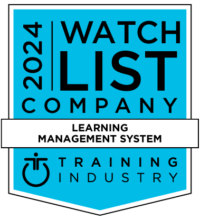Measuring training effectiveness is about more than just capturing learner logins, completions and assessment scores.
Gathering metrics on the process, participation and outcomes of workforce training and learning and development (L&D) programs is critical for helping employees grow. This data is also extremely valuable for measuring training effectiveness and business impact to make sure your programs are meeting expectations and needs.
Leveraging a performance management solution alongside a robust learning management system allows you to tap into valuable data insights to better inform your talent development strategy. But measuring training effectiveness is about more than just capturing learner logins, completions and assessment scores to truly understand the efficiency and effectiveness of your programs.
That’s why it’s important to partner with providers that put data at the center of your L&D program, that understand your goals, and that collect and showcase the type of metrics you need in a way that’s easy to understand and useful to implement. This strategic approach allows you to measure and optimize training program performance, which is essential for continuous improvement and maximizing results.
Here’s why data management should be a central piece of your L&D program, and why choosing the right solution providers can make all the difference.
1. To assess training engagement. What good is training if people aren’t participating? Assessing professional development engagement can help you not only track program impact but also demonstrate the value in learning and participating. When you can plot a positive correlation between career advancement, salary increases, etc. alongside high levels of training engagement, this can serve as a strong incentive for participation.
To gather valuable engagement data, start with a few simple metrics, such as:
- Course participation, completion rates and frequency of login. This can identify whether employees are participating in training voluntarily or because they’re required to do so, and help you to address motivational issues by demonstrating the value of continuous learning.
- Length of time required for completion. Tracking detailed time to completion can help identify stumbling blocks at certain points in the content. Is it too hard? Is the content not clear or not resonating with learners? Perhaps there are cultural issues that create friction. All of this can impact comprehension and retention, and ultimately training success.
- Success metrics per time of day. Are employees more engaged at certain times? Are quiz/assessment scores better in the morning versus afternoon? Tracking this data can help identify best practices for rollout and delivery, especially for required certifications, like safety training, when employees need to get it right.
- Sentiment. How do employees feel about the courses you offer? Do they find them interesting? Valuable? Inclusive? Gather feedback to gauge employee sentiment and incorporate their input into modules. This demonstrates that you prioritize their needs and continuous improvement, which can fuel peer encourage among learners.
You can also use training engagement data for predictive suggestions to encourage training participation. By tracking career growth alongside training, you can suggest specific courses to employees in much the same way Amazon suggests products, e.g., “people in your role or who completed this training also like this program…”
2. To ensure knowledge retention and application. Learners can easily forget what they’ve learned, especially if it’s not applied right away. By some measures, we forget 40% of what we’ve learned after just one week, and according to Ebbinghuas’ “The Forgetting Curve,” it could be as high as 75% within just six days.
While it’s impossible to measure how much employees will forget with any accuracy, we all know that the adage “use it or lose it” applies, and without retention, training is pointless. Employees must be able to apply, implement and use what they’ve learned.
Ensure “stickiness” by measuring the impact of course presentation. For example, some people are visual-, audio- or text-dominant learners and will retain more if the material is presented in their preferred style. Survey for employee feedback on course material to see what learners prefer, and offer materials in a variety of formats that fit different styles.
You should also assess retention in a variety ways and time increments. Rather than just relying on course completion/certification, use applied assessments—have employees demonstrate use of the material, beyond just passing the quiz. And extend retention assessment beyond the immediate completion of the course to ascertain how much they retain a week later, two weeks or even a month later. Based on that insight, reinforce what they’re forgetting, and consider adjusting the format and duration of training (hours-long or day-long events vs. short micro-training sessions, for example) based on data analysis of what works better.
3. To measure changes in behavior or desired outcomes. The purpose of training isn’t just to train; a learning & development (L&D) program must be designed to achieve specific businesses goals, whether it’s a decrease in accidents, improved product quality, employee skills advancement or to build a leadership funnel. The only way to know if your L&D program is effective is to measure against those KPIs/performance outcomes—start by establishing a baseline and measure frequently to see whether it improves over time.
The Kirkpatrick model has become the gold standard of measurement, but for many, quantifying impact is still a major challenge. Over 2/3 of training professionals feel pressured to measure learning impact and 96% know they need to do it, but only 50% are actually evaluating learning based on ROI, job performance and organization impact.
One way to solve the problem is by combining quantitative data (like metrics pulled from LMS) with qualitative data like employee feedback and observation to help determine what’s working and what’s not. This can help you identify programmatic issues like whether only certain departments or job roles are not adopting the change. Perhaps it’s because the training isn’t personalized to their roles or needs? Creating and offering custom content can help, as well as connecting training content to context of job roles and why it matters to showcase the benefits for both the trainee and the organization.
4. To ensure ROI. Aside from skills development and meeting compliance requirements, L&D is a strategic role that’s tied directly to talent strategy, the organization’s ability to attract and retain talent, and to develop talent and leadership. In high-performing organizations, the L&D function supports the implementation of the business strategy, and data shows that companies that invest in developing leaders are 2.4 times more likely to hit their performance targets.
Yet only 40% of companies say that their learning strategy is aligned with their business goals, which means they’re likely not realizing a positive ROI from their L&D programs. To make sure your L&D program delivers real business value, start by establishing clear business goals related to outcomes, then collect and analyze data learning to determine whether those business goals are being met.
In addition to measuring the outcomes as mentioned above, also consider whether the cost and investment in your LMS and training program is efficient. Is the platform easy to use? Or is it cumbersome and waste HR or training staff time and resources? Are employees actually using the resources you’re offering? All of these directly impact ROI and provide valuable data that can inform L&D program improvement.
Ultimately, failing to gather and leverage data in a L&D program makes it impossible to determine whether it’s working, and if not, how to improve. That means your organization and your employees are unlikely to see real benefit from the investment you’ve made in training. Instead, investing in solutions that put data at the center of your L&D strategy is the only way to ensure overall programmatic success.








